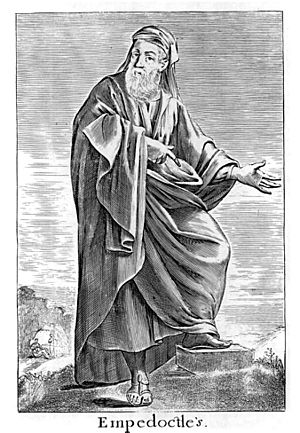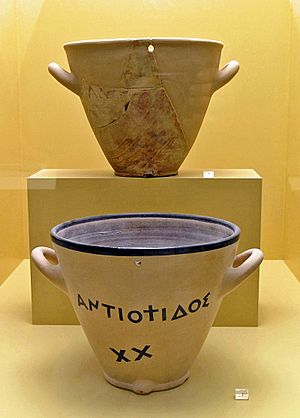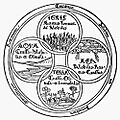Empedocles facts for kids
Quick facts for kids
Empedocles
|
|
|---|---|

Empedocles, 17th-century engraving
|
|
| Born | c. 494 BC |
| Died | c. 434 BC |
| Era | Pre-Socratic philosophy |
| Region | Western philosophy |
|
Main interests
|
Cosmogony, Biology |
|
Notable ideas
|
Classical four elements: fire, air, earth and water Love and Strife as opposing physical forces |
|
Influences
|
|
Empedocles (born around 494 BC, died around 434 BC) was an important Greek philosopher from Akragas, a Greek city in Sicily. He is known as a pre-Socratic philosopher, meaning he lived and taught before the famous philosopher Socrates.
Empedocles is most famous for his idea that everything in the world is made of four basic parts, or elements: fire, air, earth, and water. He also believed that two forces, which he called Love and Strife, caused these elements to mix together or pull apart.
He was also against sacrificing animals and eating meat. Empedocles had unique ideas about reincarnation, believing that souls could be reborn into different bodies. He was one of the last Greek philosophers to write his ideas in poetry. Many of his writings have survived, more than any other pre-Socratic philosopher. Stories about his death became famous myths.
Contents
Who Was Empedocles?
While we don't know the exact dates of Empedocles' birth and death, most historians agree he was born in the early 5th century BC. He came from Akragas, a Greek city in what is now Sicily. Scholars believe he came from a wealthy and important family. His grandfather, also named Empedocles, won a horse race at the ancient Olympic Games around 496-495 BC.
Most of what we know about Empedocles' life comes from writings made centuries after he lived. These stories often mixed facts with interpretations of his poems. For example, some stories say he was a doctor or a miracle worker, but these ideas likely came from his writings.
Empedocles' Big Ideas
Modern scholars think Empedocles was responding to the ideas of Parmenides, another philosopher who believed everything was one single thing (monism). Empedocles likely knew about the work of Anaxagoras, who also had ideas about how the world was made. Many ancient stories say Empedocles studied with the Pythagoreans because of his belief in reincarnation. However, he might have learned this idea from local traditions instead.
The Four Elements: Building Blocks of the World
Empedocles taught that everything in the world is made from four main "roots" or elements: fire, air, water, and earth. He even gave these elements mythical names like Zeus, Hera, Nestis, and Aidoneus.
He believed that these four elements are eternal and cannot be destroyed or changed. The different things we see in the world are created by these elements mixing together in various amounts. When things grow or shrink, it's just the elements combining or separating. Nothing truly new is created; it's just a rearrangement of the existing elements. This idea of the four elements became a very important belief for the next two thousand years.
Love and Strife: The Forces of Change
Since the elements themselves don't change, Empedocles needed to explain what made them mix and separate. He proposed two powerful, divine forces: Love (Philotes) and Strife (Neikos).
- Love is the force that brings different elements together, causing them to combine.
- Strife is the force that pulls elements apart, causing them to separate.
These forces are like the attraction and repulsion we see in human behavior, but they also work throughout the entire universe. Love and Strife are always battling for control, but neither ever completely wins.
Empedocles imagined a time when all the pure elements and these two forces existed together in a perfect, still sphere. Love was in charge, holding everything together, while Strife stayed at the edges. Over time, Strife gained more power, and the sphere broke apart. This led to the world we see today, full of different things and changes, all shaped by Love and Strife. Empedocles believed the universe goes through cycles, where the elements eventually return to the sphere, ready for the next cycle.
He used these ideas to explain how the Earth, sea, Sun, Moon, and atmosphere formed. He also talked about how plants and animals first appeared, and how human bodies work.
Reincarnation and the Soul
Like Pythagoras, Empedocles believed in the transmigration of the soul, also known as metempsychosis. This means he thought souls could be reborn into humans, animals, and even plants.
He believed that humans were originally long-living spirits who lived happily until they committed a crime, perhaps like shedding blood. As a punishment, they fell to Earth. They would then have to go through 30,000 cycles of being reborn into different bodies before they could return to a divine state. How a person behaved in one life would affect their next incarnation. Wise people, who understood the secrets of life, were closer to becoming divine and could escape the cycle of rebirth sooner, finding eternal happiness.
Empedocles was a vegetarian and encouraged others to be vegetarian. He believed that animal bodies were also places where punished souls lived. For him, all living things, including plants, animals, and humans, were connected in a spiritual chain.
Light, Vision, and Breathing
Empedocles is credited with one of the first detailed theories about light and vision. He suggested that light takes time to travel from one place to another. He also thought that we see objects because light streams out of our eyes and touches them. Even though this idea was later proven wrong, it was an important starting point for other Greek philosophers and mathematicians like Euclid to develop their own theories about light and vision.
He explained knowledge by saying that we understand things outside us because we have similar elements inside ourselves. For example, we know "like by like." He also believed that our whole body has tiny holes, or pores, through which we breathe.
Empedocles also tried to explain how we breathe using an example of a clepsydra. A clepsydra was an ancient device used to move liquids. He used the way water flowed out of it to explain how air moves in and out of our bodies. This showed that Empedocles understood that air was a physical substance.
Empedocles' Writings
Empedocles wrote two main poems: "On Nature" and "On Purifications." Together, they were said to have 5,000 lines, but only about 550 lines have survived. These surviving lines were quoted by later ancient writers.
"On Nature" explained his philosophical system. It covered the universe's history, his four-element theory, and ideas about how things happen, how we perceive things, and how we think. It also explained natural events and biological processes. "On Purifications" was thought to be about religious rituals and his ethical beliefs.
However, a discovery in 1999 of a papyrus (an ancient paper-like material) called the Strasbourg Empedocles papyrus changed things. It contained parts of "On Nature" that included lines previously thought to be from "On Purifications." This has led to a debate among scholars about whether he wrote two separate poems or if all the surviving fragments come from one long poem with two different titles.
Empedocles' Lasting Impact
Aristotle said Empedocles died at age sixty, but other ancient writers claimed he lived much longer. There are many myths about his death. One famous story, recorded by Diogenes Laërtius, says Empedocles threw himself into the volcano Mount Etna in Sicily. He supposedly wanted people to believe he had become an immortal god. However, the volcano supposedly threw back one of his bronze sandals, revealing his trick. Another version says he did it to prove his immortality to his students, believing he would return as a god.
The Roman poet Lucretius admired Empedocles greatly and saw him as a role model. The poet Horace also mentioned Empedocles' death in his work. Empedocles' death has inspired many writers, including Friedrich Hölderlin's play The Death of Empedocles and Matthew Arnold's poem Empedocles on Etna.
Some scholars believe Empedocles likely did not die in Sicily, and that both the positive story of him being taken to heaven and the negative one about him jumping into a volcano were easily accepted by ancient writers because there was no local evidence to say otherwise.
Images for kids
See also
 In Spanish: Empédocles para niños
In Spanish: Empédocles para niños










